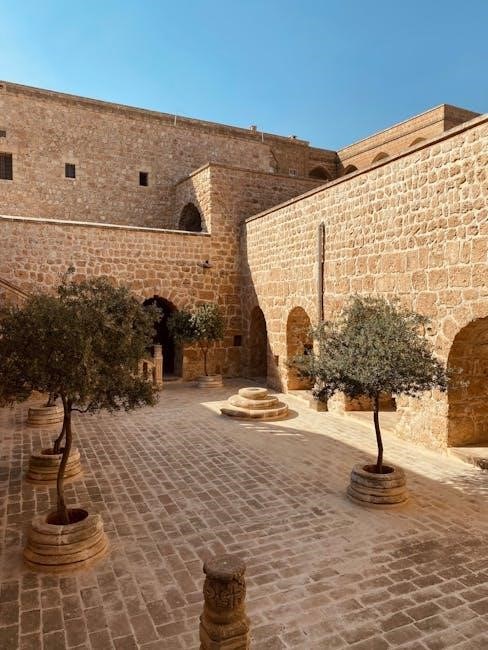Old Testament miracles are divine acts that demonstrate God’s power and purpose, validating His messengers and revealing His plan of salvation and judgment.
1.1 Definition of Miracles in the Biblical Context
A miracle in the biblical context is an extraordinary event that surpasses natural laws, demonstrating God’s supernatural intervention. These acts are intentional, revealing His power, purpose, and character. Miracles are not random but serve to authenticate God’s messengers, validate His message, and fulfill His divine plan. They often emphasize His sovereignty, mercy, and judgment, showcasing His ability to transcend human limitations. In the Old Testament, miracles are recorded as signs and wonders, reinforcing faith and trust in God’s promises and providence, while illustrating His ultimate plan of salvation and redemption for humanity.
1.2 Purpose of Miracles in the Old Testament
Miracles in the Old Testament served to validate God’s messengers, authenticate His message, and demonstrate His divine power and sovereignty. They were often used to deliver His people, such as the Israelites, from oppression, showcasing His mercy and faithfulness. Miracles also highlighted God’s judgment against disobedience and evil, while providing supernatural provision in times of need. Ultimately, these acts revealed God’s character, reinforced His covenant promises, and pointed to His ultimate plan of salvation. Through miracles, God’s presence and authority were made evident, inspiring faith and trust in His people.
1.3 Overview of Key Miracles in the Old Testament
The Old Testament is rich with miraculous events that highlight God’s power and divine intervention. Key miracles include the creation of the world, the worldwide flood, and the parting of the Red Sea. Other notable events are the confusion of languages at Babel, the fall of Jericho’s walls, and the supernatural provision of manna and water in the wilderness. These miracles demonstrate God’s sovereignty, mercy, and judgment, while validating His messengers and fulfilling His purposes. They serve as foundational moments in Israel’s history, revealing God’s character and His plan for humanity.

Miracles in the Book of Genesis
The Book of Genesis records foundational miracles, such as creation, the flood, and the confusion of languages, showcasing God’s power and divine intervention in human history.
2.1 Creation of the World (Genesis 1:1-27)
The creation of the world, as recorded in Genesis 1:1-27, is the ultimate miracle, where God spoke and brought all existence into being through His divine power. This act establishes God as the omnipotent Creator, demonstrating His ability to form complexity and order from nothing. The creation narrative highlights God’s intentional design, separating light from darkness, land from sea, and culminating in the creation of humanity in His image. This miracle sets the foundation for understanding God’s nature and His relationship with humanity, showcasing His sovereignty and wisdom in crafting the universe.
2.2 Enoch’s Translation (Genesis 5:24)
Enoch’s translation is a remarkable miracle where he was taken directly to heaven without experiencing death. Genesis 5:24 records that Enoch “walked with God, and he was not, for God took him.” This divine act underscores God’s pleasure in Enoch’s faithful and righteous life. Unlike others in Genesis 5, Enoch’s life ended uniquely, demonstrating God’s supernatural intervention. This miracle highlights the possibility of escaping death through divine favor, serving as a testament to the power of a life lived in close communion with God. It also prefigures the ultimate hope of believers in eternal life with Him.
2.3 The Worldwide Flood (Genesis 7-8)
The worldwide flood, recounted in Genesis 7-8, is a significant Old Testament miracle. God, seeing the earth’s wickedness, sent a flood to destroy humanity and start anew. Noah, obedient to God’s command, built an ark where he, his family, and two of each animal survived. The floodwaters, miraculously provided by God, covered the earth for 150 days, eradicating corruption. After the flood, God established a covenant with Noah, promising never to destroy the earth with a flood again, symbolized by the rainbow. This event demonstrates God’s judgment and mercy, setting the stage for humanity’s redemption.
2.4 Confusion of Languages at Babel (Genesis 11:1-9)
The confusion of languages at Babel, recorded in Genesis 11:1-9, is a remarkable Old Testament miracle. Humanity, united in pride, attempted to build a tower reaching heaven. God, seeing their arrogance, miraculously confused their language, causing widespread misunderstanding. This divine intervention halted the tower’s construction and scattered the people across the earth. The miracle underscores God’s sovereignty over human ambition and explains the origin of diverse languages. It serves as a reminder of His authority to interrupt human plans when they defy His will, while also highlighting His desire to prevent unity in wickedness. This event remains a pivotal moment in biblical history.
Miracles in the Book of Exodus
The Book of Exodus recounts profound miracles, including the Ten Plagues, parting the Red Sea, and provision of manna and water, showcasing God’s power and salvation.
3.1 The Ten Plagues of Egypt
The Ten Plagues were a series of miraculous judgments sent by God to compel Pharaoh to release the Israelites from slavery. These plagues included turning water into blood, unleashing frogs, lice, flies, a deadly pestilence, boils, hail, locusts, darkness, and finally, the death of every firstborn son. Each plague demonstrated God’s power and His desire to free His people, culminating in the Passover, where the Israelites were spared by the blood of the lamb. These events remain a testament to God’s authority and mercy, shaping Israel’s identity and faith.
3.2 Parting of the Red Sea (Exodus 14:13-31)
The parting of the Red Sea was a miraculous event where God, through Moses, divided the waters, allowing the Israelites to escape Pharaoh’s pursuing army. Moses, by faith, stretched his staff over the sea, and a strong east wind parted the waters, creating a dry path. The Israelites crossed safely, but when the Egyptians followed, the waters returned, destroying their army. This miracle demonstrated God’s power to deliver His people and marked a pivotal moment in Israel’s liberation from slavery, solidifying their trust in Him and His covenant promises.
3.4 Manna and Water in the Wilderness
During their wilderness journey, God miraculously provided manna, a supernatural bread, for the Israelites daily for 40 years. He also supplied water from a rock when Moses struck it, sustaining His people. These miracles demonstrated God’s faithfulness and provision, meeting their physical needs despite their disobedience. The manna and water served as a testament to God’s covenant love and His ability to provide in the most desolate circumstances, reinforcing the Israelites’ dependence on Him and foreshadowing spiritual nourishment in Christ.

Miracles in the Book of Joshua
The fall of Jericho’s walls and the stopping of the sun and moon highlight God’s supernatural intervention, showcasing His power and support for Joshua’s leadership.
4.1 Fall of Jericho’s Walls (Joshua 6)
The fall of Jericho’s walls is a remarkable miracle where God caused the walls to collapse after the Israelites marched around the city for seven days. This event demonstrated God’s faithfulness to His promises and His supernatural power in fulfilling them. It also highlighted the importance of obedience, as Joshua and the Israelites followed God’s specific instructions without questioning. The miracle not only led to the conquest of Jericho but also served as a testament to God’s presence and might, encouraging the Israelites in their future endeavors. This act of divine intervention remains a significant example of God’s deliverance and provision.
4.2 Stopping of the Sun and Moon (Joshua 10:12-14)
The stopping of the sun and moon during Joshua’s battle against the Amorites is one of the most extraordinary miracles in the Old Testament. According to Joshua 10:12-14, Joshua prayed for the sun and moon to stand still, extending daylight to complete the victory. This miraculous event demonstrated God’s direct intervention in battle and His control over creation. The precise fulfillment of Joshua’s prayer underscored God’s faithfulness and power, providing a decisive victory for the Israelites. This miracle remains a testament to God’s ability to alter natural phenomena for His purposes, showcasing His divine authority and support for His people.
Miracles in the Book of Judges
Judges records divine interventions, including Gideon’s fleece and Samson’s strength, showing God’s power in delivering Israel through ordinary individuals.
5.1 Gideon’s Fleece (Judges 6:36-40)
Gideon, uncertain of God’s plan, tested divine guidance by asking for a sign involving a fleece. First, the fleece was wet with dew while the ground remained dry. Then, the fleece was dry while dew covered the ground, confirming God’s promise to deliver Israel through him. This miracle underscored God’s patience and willingness to strengthen Gideon’s faith before leading Israel against Midian.
5.2 Samson’s Supernatural Strength

Samson, a judge of Israel, was endowed with extraordinary physical strength by God, enabling him to accomplish feats beyond human capability. This divine empowerment allowed him to slay a lion with his bare hands, defeat armies, and remove massive gates. His strength was a visible manifestation of God’s Spirit, demonstrating divine power and judgment against the Philistines. However, his strength was contingent on his obedience, as it departed when his hair was cut. Despite his flaws, Samson’s final act of faith, toppling the temple, showed God’s grace and power even in his vulnerability.

Miracles in the Books of Samuel and Kings
The books of Samuel and Kings recount remarkable miracles, showcasing divine intervention through prophets like Elijah and Elisha, who performed extraordinary acts of healing and provision.
6.1 Elijah Raises the Widow’s Son (1 Kings 17:17-24)
Elijah, a prophet of God, performed a remarkable miracle by raising the widow’s son from death. During a severe famine, Elijah was hosted by a widow in Zarephath whose son fell ill and died. Moved by her grief, Elijah prayed fervently, and God resurrected the child. This miracle demonstrated Elijah’s faith and God’s mercy, providing comfort to the widow and validating Elijah’s divine mission. It also served as a testament to God’s power over life and death, showcasing His ability to intervene miraculously in human affairs.
6.2 Fire on Mount Carmel (1 Kings 18:20-40)
Elijah confronted the prophets of Baal on Mount Carmel, challenging them to prove their god’s power. After their failed attempts, Elijah repaired the altar, poured water over the sacrifice, and prayed. Fire from heaven consumed the offering, wood, stones, and water, demonstrating God’s supreme power. This miracle confirmed Elijah’s message, led the people to repentance, and ended the drought. It showcased God’s ability to dramatically intervene, validating Elijah’s prophetic authority and leaving a lasting impact on Israel’s faith.
6.3 Elisha and the Widow’s Oil (2 Kings 4:1-7)
A widow facing debt and the possibility of losing her sons approached Elisha for help. He instructed her to gather all available vessels and pour oil from her single jar into them. Miraculously, the oil multiplied, filling every vessel. This act of supernatural provision allowed the widow to sell the oil, pay her debts, and live comfortably with her sons. The miracle demonstrated Elisha’s compassion and God’s care for the needy, highlighting divine intervention in times of financial and emotional distress.
6.4 Elisha Heals Naaman’s Leprosy (2 Kings 5)
Naaman, a Syrian military leader, suffered from leprosy. Learning of Elisha’s prophetic abilities, he sought healing. Elisha instructed Naaman to dip himself seven times in the Jordan River. Initially skeptical, Naaman obeyed and was miraculously cured. This miracle showcased God’s power to heal and demonstrated Elisha’s role as a divine messenger. It also highlighted Naaman’s humility and faith, leading to his spiritual transformation and recognition of the one true God, as he acknowledged the Lord’s supremacy over all other deities.

Miracles Involving Daniel
Daniel’s miracles include survival in the lions’ den and interpretation of dreams, demonstrating God’s divine protection and Daniel’s unwavering faith in His sovereignty.
7.1 Daniel in the Lions’ Den (Daniel 6)
Daniel’s miraculous survival in the lions’ den (Daniel 6) highlights God’s divine protection. After refusing to worship King Darius, Daniel was thrown into a den of lions. An angel sealed the lions’ mouths, ensuring his safety. The next morning, Daniel emerged unharmed, demonstrating God’s faithfulness. This miracle showcased Daniel’s unwavering faith and trust in God, even in the face of certain death. The event not only amazed King Darius but also reinforced the power of prayer and divine intervention, solidifying Daniel’s legacy as a man of extraordinary faith.
7.2 The Fiery Furnace and Shadrach, Meshach, and Abednego (Daniel 3)
The miracle of Shadrach, Meshach, and Abednego in the fiery furnace (Daniel 3) exemplifies divine deliverance. Refusing to worship Nebuchadnezzar’s statue, they were thrown into a blazing furnace. Miraculously, they emerged unharmed, walking freely as a fourth figure, likened to the Son of God, joined them. This act of faith and divine intervention demonstrated God’s power to protect His people in the face of persecution. The event not only astounded King Nebuchadnezzar but also served as a testament to the trio’s unwavering commitment to their faith and the miraculous ways God delivers His servants from harm.
Major Themes and Patterns
Old Testament miracles reveal recurring themes of deliverance, divine judgment, mercy, and supernatural provision, emphasizing God’s sovereignty and covenant faithfulness to His people.
8.1 Deliverance and Salvation
Miracles in the Old Testament often served as acts of deliverance, rescuing God’s people from oppression and danger. The parting of the Red Sea and the fall of Jericho’s walls exemplify divine intervention for salvation. These events highlighted God’s faithfulness to His covenant promises, demonstrating His power to save and protect. Such miracles not only delivered physically but also reinforced spiritual faith, showcasing God’s role as Savior and Redeemer. They foreshadowed future redemption through Christ, emphasizing salvation as a central theme of God’s interaction with humanity.
8.2 Divine Judgment and Mercy
Old Testament miracles often reflect God’s dual nature of judgment and mercy. The ten plagues upon Egypt and the destruction of Sodom and Gomorrah illustrate divine judgment, punishing sin and rebellion. Conversely, miracles like the sparing of Israel during the plagues and the preservation of Noah’s family during the flood demonstrate God’s mercy. These acts reveal His justice balanced with compassion, warning humanity of sin’s consequences while offering hope for repentance and redemption. Such miracles underscore God’s sovereignty and His desire to draw people back to Himself, blending judgment with merciful deliverance.
8.3 Supernatural Provision
Supernatural provision in the Old Testament highlights God’s care for His people through extraordinary means. Manna and water in the wilderness sustained Israel, demonstrating God’s faithfulness despite their unbelief. The parting of the Red Sea and Jordan River provided safe passage, symbolizing divine deliverance. These miracles not only met physical needs but also reinforced Israel’s trust in God’s promises. Such acts of provision underscored God’s covenant love and His ability to supply abundantly in times of need, serving as a foundation for faith in His ongoing care and redemption.

Theological Significance of Old Testament Miracles
Old Testament miracles reveal God’s nature, validate His messengers, and prefigure Christ’s redemptive work, demonstrating divine authority and the fulfillment of His covenant promises.
9.1 Validation of God’s Messengers
Miracles in the Old Testament often served as divine validation of God’s messengers, proving their authority and authenticity. Prophets like Moses, Elijah, and Elisha performed miracles that confirmed their divine commission. For instance, Moses’ ability to bring the Ten Plagues upon Egypt and part the Red Sea demonstrated God’s endorsement of his leadership. Similarly, Elijah’s resurrection of the widow’s son and Elisha’s healing of Naaman’s leprosy validated their roles as messengers of God. These miracles were not merely spectacles but signs that underscored the credibility of their message and aligned with God’s larger plan of redemption and revelation.
9.2 Demonstration of God’s Power
Old Testament miracles vividly demonstrate God’s omnipotence and sovereignty over creation. From the creation of the world to the parting of the Red Sea, these acts reveal God’s unparalleled power. The Ten Plagues, the fall of Jericho’s walls, and the stopping of the sun in Joshua’s battle showcase His control over nature and human affairs. These miracles not only awed observers but also reinforced God’s identity as the Almighty, who intervenes in history to fulfill His purposes. Such displays of power underscored His authority and inspired faith in His people, leaving an indelible mark on Israel’s understanding of His divine nature and majesty.
9.3 Typological Significance for New Testament Miracles
Old Testament miracles often serve as typological precursors to New Testament events, foreshadowing God’s ultimate redemption through Christ. The parting of the Red Sea, for instance, symbolizes baptism and salvation, while Elisha’s miracles, like feeding a hundred men with a few loaves, prefigure Jesus’s multiplication of bread. These patterns highlight God’s consistent nature and His progressive revelation of grace. Such typological connections emphasize Jesus as the fulfillment of Old Testament promises, illustrating how earlier miracles pointed to His divine power and redemptive work, bridging the old covenant with the new.
The Old Testament miracles underscore God’s sovereignty, mercy, and redemptive plan, leaving an enduring legacy that shapes faith and understanding of divine intervention in human history.
10.1 Summary of Key Miracles
The Old Testament records a comprehensive list of miracles, each showcasing God’s divine intervention. From creation and the worldwide flood to the parting of the Red Sea and the fall of Jericho’s walls, these events highlight God’s power and purpose. Key miracles include the ten plagues of Egypt, manna in the wilderness, and supernatural acts by Elijah and Elisha. These miracles demonstrate deliverance, judgment, and provision, reinforcing God’s sovereignty and redemptive plan. They serve as foundational testimonies of His faithfulness, profoundly shaping the theological and historical narrative of the Bible.
10.2 The Enduring Impact of Old Testament Miracles
Old Testament miracles hold profound theological and historical significance, shaping the understanding of God’s character and redemptive plan. They validate divine messengers, demonstrate God’s power, and foreshadow New Testament events. These miracles inspire faith, trust, and obedience, showcasing God’s mercy, judgment, and supernatural provision. Their enduring impact lies in their ability to reveal God’s sovereignty and love, emphasizing His active involvement in human history; They remain foundational to Christian theology, offering timeless lessons on God’s faithfulness and the fulfillment of His promises, resonating across generations as a testament to His divine nature and redemptive purposes.
